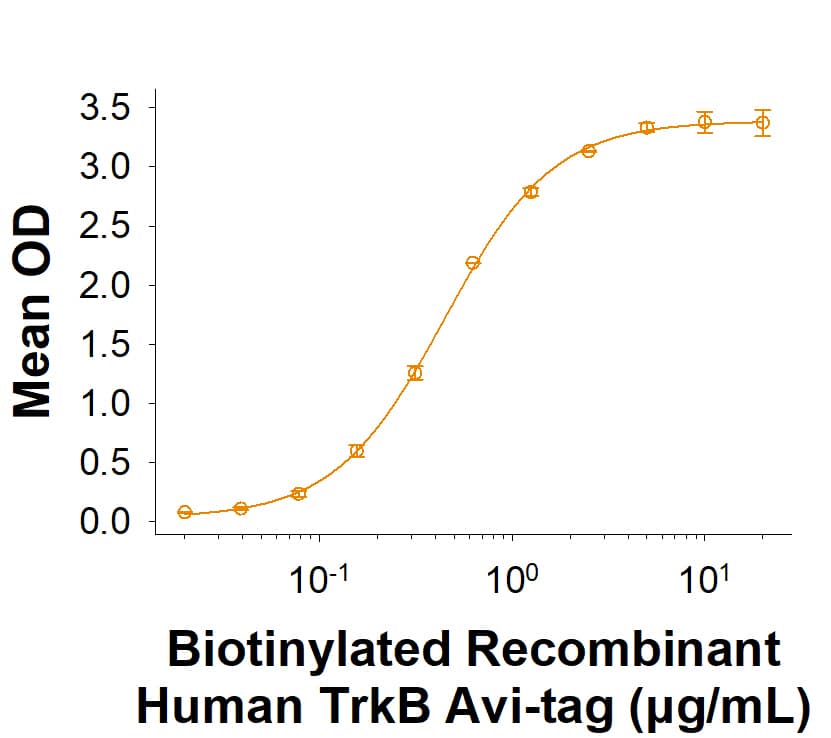Recombinant Human TrkB His-tag Avi-tag Protein, CF
R&D Systems, part of Bio-Techne | Catalog # AVI11549

Key Product Details
Source
Structure / Form
Conjugate
Applications
Product Specifications
Source
| Human TrkB (Cys32-His430) Accession # Q16620.1 |
6-His tag | Avi-tag |
| N-terminus | C-terminus |
Purity
Endotoxin Level
N-terminal Sequence Analysis
Predicted Molecular Mass
SDS-PAGE
Activity
Biotinylated Recombinant Human TrkB His-tag Avi-tag (Catalog # AVI11549) binds Recombinant Human BDNF (Catalog # BT-BDNF) with an ED50 of ≤5.00 μg/mL.
Scientific Data Images for Recombinant Human TrkB His-tag Avi-tag Protein, CF
Biotinylated Recombinant Human TrkB His-tag Avi-tag Protein Binding Activity.
Biotinylated Recombinant Human TrkB His-tag Avi-tag Protein (Catalog # AVI11549) binds Recombinant Human BDNF (BT-BDNF) with an ED50 of ≤ 5.00 μg/mL.Biotinylated Recombinant Human TrkB His-tag Avi-tag Protein SDS-PAGE.
2 μg/lane of Biotinylated Recombinant Human TrkB His-tag Avi-tag Protein (Catalog # AVI11549) was resolved with SDS-PAGE under reducing (R) and non-reducing (NR) conditions and visualized by Coomassie® Blue staining, showing bands at 80-90 kDa, under reducing conditions.Formulation, Preparation and Storage
AVI11549
| Formulation | Lyophilized from a 0.2 μm filtered solution in PBS with Trehalose. |
| Reconstitution | Reconstitute at 500 μg/mL in PBS. |
| Shipping | The product is shipped at ambient temperature. Upon receipt, store it immediately at the temperature recommended below. |
| Stability & Storage | Use a manual defrost freezer and avoid repeated freeze-thaw cycles.
|
Background: TrkB
The neurotrophins, including NGF, BDNF, NT-3, and NT-4/5 constitute a group of structurally related, secreted proteins that play an important role in the development and function of the nervous system. The biological activities of the neurotrophins are mediated by binding to the different members of the Trk family tyrosine kinase receptors. Three Trk family proteins, TrkA, TrkB, and TrkC, exhibiting different ligand specificities, have been identified. TrkA binds NGF, TrkB binds BDNF and NT‑4/5 and TrkC binds NT-3. All Trk family proteins share a conserved complex subdomain organization consisting of a signal peptide, two cysteine-rich domains, a cluster of three leucine-rich motifs, and two immunoglobulin-like domains in the extracellular region, as well as an intracellular region that contains the tyrosine kinase domain. Natural splice variants of the different Trks, including TrkB variants lacking the first cysteine-rich domain, the first and second or all three of the leucine-rich motifs, or the tyrosine kinase domain, have been described. The role of the different extracellular subdomains of TrkB in mediating neurotrophin binding and discrimination is currently being investigated. At the protein sequence level, human and rat TrkB are greater than 90% identical and the proteins exhibit cross-species activity. TrkB is primarily expressed in the nervous system. However, low levels of TrkB expression have also been observed in a wide variety of tissues (pancreas, kidneys, ovary) outside the nervous system. Our Avi-tag Biotinylated human TrkB features biotinylation at a single site contained within the Avi-tag, a unique 15 amino acid peptide. Protein orientation will be uniform when bound to streptavidin-coated surface due to the precise control of biotinylation and the rest of the protein is unchanged so there is no interference in the protein's bioactivity.
References
- Ninkina, N. et al. (1997) J. Biol. Chem. 272:13019.
- Middlemas, D.S. et al. (1991) Mol. Cell Biol. 11:143.
- Soppet, D. et al. (1991) Cell 65:895.
Long Name
Alternate Names
Gene Symbol
Additional TrkB Products
Product Documents for Recombinant Human TrkB His-tag Avi-tag Protein, CF
Product Specific Notices for Recombinant Human TrkB His-tag Avi-tag Protein, CF
For research use only

